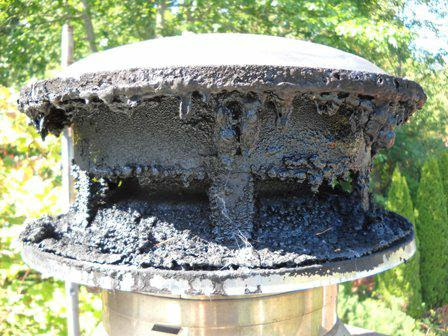
Creosote Remover for Outdoor Wood Furnace
Creosote is a nasty black tar that builds up inside your outdoor wood boiler. Creosote causes the following problems:
1. It makes your outdoor wood boiler consume much more wood than it costs you time and money!
2. It is harmful to your outdoor furnace's steel surfaces
3. Creosote reduces the efficiency of your outdoor wood boiler.
4. It can cause dangerous chimney fires
5. Can reduce airflow through the outdoor wood boiler and even completely stop preventing the boiler from operating.
Clearly, creosote should be minimized. And any creosote that does build up, MUST be removed.
Here is the definitive solution for MINIMIZING creosote buildup and REMOVAL of any creosote that does occur. These are the
Top 4 Ways to Eliminate Harmful Creosote
1. Use the Best Creosote Remover Sticks
2. Follow the "Dry Burn" Procedure
3. Always operate your outdoor wood stove with water jacket temps above140 F
4. Use Properly Seasoned wood
Easy Creosote Remover Stick

This creosote remover for wood stoves will help you max your outdoor wood boiler efficiency. Just toss one stick into your burn pot fire once per week for maximum effectiveness.
1. It makes your outdoor wood boiler consume much more wood than it costs you time and money!

2. It is harmful to your outdoor furnace's steel surfaces
3. Creosote reduces the efficiency of your outdoor wood boiler.
4. It can cause dangerous chimney fires
5. Can reduce airflow through the outdoor wood boiler and even completely stop preventing the boiler from operating.
Clearly, creosote should be minimized. And any creosote that does build up, MUST be removed.
Here is the definitive solution for MINIMIZING creosote buildup and REMOVAL of any creosote that does occur. These are the
Top 4 Ways to Eliminate Harmful Creosote
1. Use the Best Creosote Remover Sticks
2. Follow the "Dry Burn" Procedure
3. Always operate your outdoor wood stove with water jacket temps above140 F
4. Use Properly Seasoned wood
Easy Creosote Remover Stick

This creosote remover for wood stoves will help you max your outdoor wood boiler efficiency. Just toss one stick into your burn pot fire once per week for maximum effectiveness.
The use of wood stove creosote remover does not eliminate the need for regular chimney cleaning. Safe for use in all chimneys and wood-burning appliances.
This new product is the BEST way to remove creosote - just toss one stick into the fire in your outdoor wood boiler, and in 24 hours, creosote will be eliminated!
It is recommended to use at least one or two creosote remover sticks in your outdoor wood boiler per month, and two sticks during the final week before shutting down the outdoor wood boiler for summer.
Dry Burn Procedure
The best way to minimize creosote from even forming inside your boiler is in how you operate your outdoor wood boiler. The most effective way is called the Dry Burn procedure, which requires burning each load of wood almost completely so that the final few hours of burning are when only dry coals remain.
Learn more about the Dry Burn Procedure - read our article on this topic by clicking on this link HERE.
Never Operate Boiler at Temps Below 140 F

Since even the most seasoned hardwood contains 20 percent moisture, burning wood requires eliminating this moisture. In normal operations, we want that moisture to exit the furnace harmlessly in the form of steam.
However, some of that steam will condense if ash levels get deep, and most critically, if the water jacket temp drops below 140F, then substantial amounts of condensation form, which leaves a thick layer of creosote. Learn more by watching the video on this topic HERE.
Use Properly Seasoned Wood

Your firewood should be seasoned. Green wood contains far too much moisture (up to 50%) and does not burn well. High moisture content wood requires up to 40% of the heating value of your to burn off the moisture and convert it to steam. This is heat that otherwise would go into your home.
To properly season firewood, it must be cut, split, stacked, and covered on top, but not on the sides so air can flow through the woodpile. Many customers report that after 6-9 months, their wood is properly seasoned.




